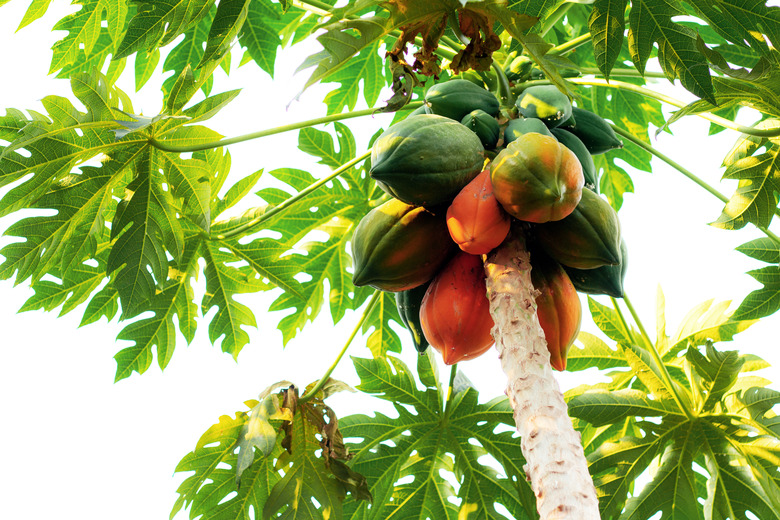What Type Of Papaya Tree Do I Have?
Tall, slender and attractive, the papaya tree (Carica papaya, USDA zones 10-12) is so much more than a pretty part of a larger landscape. A papaya tree makes a fantastic shade tree that can also produce healthy fruit you can use in a wide variety of ways. A papaya tree will surprise you with all it offers if you live in the right climate and have the right planting conditions to grow one.
Types of Papaya Trees
The broadleaf papaya tree is either male, female or hermaphrodite, meaning they can be both. The gender of the papaya tree can change. Warmer temperatures can make the tree switch to male. Hot temperatures and beheading can force the tree to turn female.
You usually can't identify a papaya tree until three to six months after it has been transplanted and is able to bloom.
Male and Female Papaya Trees
To identify a male papaya tree, you will need to investigate the flowers. Male papaya trees have thin, tubular flowers that shoot out of the end of the branching stalks.
If you have a female papaya tree, the blooms will be less reedy. Female papaya trees grow tiny clusters of fat-petaled papaya flowers or solitary blooms on short stalks. They will produce large fruits if they are pollinated.
Hermaphrodite Papaya Trees
The flowers of the papaya are hermaphroditic if they contain both the male and female parts to pollinate, the stamen and the pistil. The flowers are generally larger than both the male and female papaya trees.
Papaya Fruit for Cultivating
Native to southern Mexico and along tropical regions of Central and South America, the papaya is a juicy fruit that is high in vitamins and fiber. The bright yellowish-orange fruit that falls from a papaya tree is high in beneficial nutrients and is low in calories and fat.
A small, ripe papaya contains less than 70 calories. It has nearly three grams of dietary fiber for a healthy diet and a large dose of magnesium at 33 milligrams per papaya. The papaya is rife with folic acid for prenatal health.
The green-skinned papaya fruit can grow to 8 inches long.
Benefits of Papaya
Ripe papaya is sweeter than its unripe counterpart that can be used in smoothies and for drying. A fully ripe papaya is the preferred way to eat this luscious fruit, although there are many uses for unripened papaya. Unripened papayas attract wild birds and other wildlife.
The papaya has long been associated with significant health benefits. The fleshy fruit is full of vital vitamins, including:
- Vitamin C
- Vitamin E
- Beta-carotene
- Zinc
- Potassium
- Calcium
- Folate
- Vitamin K
- Vitamin A
How to Grow Papaya
The papaya tree is quick to create large globes of fruit. It is a fast grower that can loom over backyard areas to provide a wide swath of cool shade. A papaya can be grown from seed or as a transplant.
To grow juicy papaya fruit, the tree needs a few basic things, including:
- Full sun for a minimum of six hours a day.
- Plenty of long drinks from a consistent water source. The large, soft, feathery leaves of the papaya tree evaporate much of the water that they suck up through the long, slender trunk.
- Soil that is rich in organic matter with exceptional drainage. They need regular fertilizing. A cactus potting soil mix of 50 percent perlite and a good mix of large sand can help a newly planted tree to flourish and provide tasty fruit within its first few years.
- The black seeds from the fruit can be used to grow new trees under the right conditions, but hybrid cultivars may not produce viable seeds. After sowing them, keep the seeds moist and in well-draining soil to get them to sprout.
- Once a papaya seed sprouts, it will shoot up quickly, so be prepared to transplant it to an outdoor area where it can meet its full, towering potential.
Papaya Tree Facts
Before you embark on growing a stunning specimen of papaya tree, you should understand a few things about this short-lived, fast-growing fruit tree.
A papaya tree can produce fruit within its first year. However, the older the tree, the sweeter the fruit. Young trees can provide lovely unripened fruit that has many uses.
Papaya trees grow best in warmer climates. They can safely be grown outdoors or indoors in United States plant hardiness zones 10 through 12 without worry of freezing. A climate that doesn't dip below 32 degrees will be the most beneficial for growing a papaya tree.
